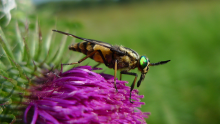Researchers at UBC and in Switzerland have applied a mathematical model to Salmonella bacteria to show how altruistic, self-destructive traits can evolve in biological populations. In the case of Salmonella, these traits could potentially result in stronger and more damaging infections.
UBC's Michael Doebeli—working with researchers at the Swiss Federal Institute of Technology in Zurich—studied what happens when Salmonella bacteria enter the gut of mice. They demonstrate that some Salmonella cells invade the lining of the gut to release inflammation-inducing molecules, laying down their lives in order to kill off competing infections. The remaining cells—genetically identical to those that sacrificed themselves—go on to thrive.
"This provides a new perspective on how bacterial pathogens evolve self-destructive cooperative acts to infect their hosts," says Doebeli, with the departments of Math and Zoology. "The mathematical models show that if enough members of a population carry the genes for selfless behaviour, but only a subset of cells actually go through with the altruistic self-sacrifice, then those genes will persist in the population because of the benefit the sacrifice confers to the survivors."
The findings were published this week in Nature.
The phenomenon, called self-destructive cooperation, can help bacterial infections gain a foothold in diseases such as Salmonella enterocolitis. But altruistic self-sacrifice is displayed throughout nature—in non-reproductive workers in mammals, fish that provide dangerous sentry duty for larger schools of brethren, and bees that die after stinging a target.
The researchers used a mathematical model based on economic game theory to help measure the probability of a species producing cooperative subpopulations. Genes encoding self-sacrificial behaviour can only survive evolutionarily if some carriers of don't go through with the sacrifice.
In Salmonella, it is thought that the phenomenon of phenotypic noise is responsible for the fact that the same genotype can exhibit different phenotypes.
"Typically we think of phenotypic noise—random variation in cell composition driven by interaction between genetics and the environment—as a way to provide diversity in a population" says Doebeli. "This model supports the idea that there's also a link between that random noise and the production of sub populations that are more likely to exhibit cooperative traits."
"In the future, exploring the underlying mechanisms of phenotypic noise enhancing infections might provide new insights into pathogen control."
Musqueam First Nation land acknowledegement
We honour xwməθkwəy̓ əm (Musqueam) on whose ancestral, unceded territory UBC Vancouver is situated. UBC Science is committed to building meaningful relationships with Indigenous peoples so we can advance Reconciliation and ensure traditional ways of knowing enrich our teaching and research.
Learn more: Musqueam First Nation
Faculty of Science
Office of the Dean, Earth Sciences Building2178–2207 Main Mall
Vancouver, BC Canada
V6T 1Z4


